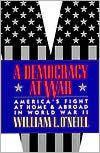

 |

|

The average rating for A Democracy at War: America's Fight at Home and Abroad in World War II based on 2 reviews is 3.5 stars.
Review # 1 was written on 2011-01-26 00:00:00 David Szyszka David SzyszkaA Democracy at War is a generally positive history of the United State's involvement in the Second World War. O'Neill describes both the events at home and the fighting. He is most critical of how the United States ended up at war with Japan, as he is of the opinion that the basic issue, Japanese intervention in China, was not a vital American interest and that it would have made more sense to appease Japan in order to have more resources to devote to a war with Germany. He is also critical of the two separate campaigns, one from Australia and the other from Hawaii, waged against Japan because neither General Douglas MacArthur nor the United States Navy were willing to be subordinate to the other. O'Neil thinks a single campaign waged from Australia would have made more sense. I found the chapters on politics and society in the United States of most interest. I found the parts on the mobilization of the economy for war, which was awkwardly done, illuminating. He also has good sections about women and racial minorities (mainly about Japanese-Americans and African-Americans, little on Hispanics). He successfully relates the politics to battlefield events; for example one reason the Battle of the Bulge was so alarming was that the army had few forces in reserve, due to the unwillingness of Congress or the Roosevelt administration to push for a more through draft. I was also surprised to learn that even in World War II polling had a noticeable influence on politics. |
Review # 2 was written on 2016-07-17 00:00:00 Michael Harpel Michael HarpelThis is a fairly readable and relatively fascinating introduction to Prohibition including the important aspects of politics, culture, gender, and race. It is, however, fundamentally flawed. On one hand, the size, racial/ethnic diversity, and cosmopolitan culture of New York City make it a perfect locale for a Prohibition study. On the other hand, I found myself continually asking: How representative of the larger American Prohibition experience is NYC? Lerner appears to argue for New York exceptionalism; he assumes a "trickle-down" effect where the anti-Prohibition attitude of New Yorkers makes its way to the rest of the nation. First, this is almost impossible to quantify. How do you prove that support for 18th Amendment repeal in, say, Indiana came from the efforts of wet New Yorkers? Second, I found a tone of "East coast bias" present throughout the book, the idea that unenlightened residents of "fly-over country" needed the example of New Yorkers to wake up to the dangers of the 18th Amendment. Maybe the other 47 states simply liked to drink as much as New York. A good study when sticking to New York City, but unconvincing when attempting to make larger claims about American society. |
CAN'T FIND WHAT YOU'RE LOOKING FOR? CLICK HERE!!!